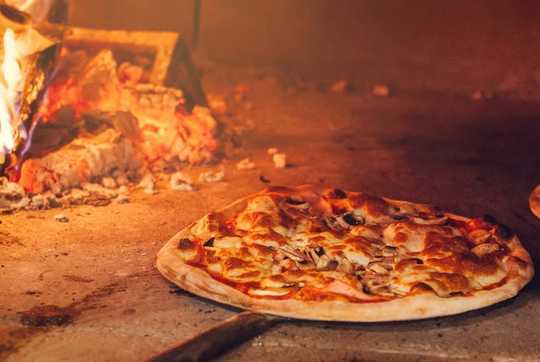
One slice is never enough. Radu Bercan/Shutterstock.com
Pizza is one of the world’s most popular foods.
In the U.S., 350 slices are eaten every second, while 40% of Americans eat pizza at least once a week.
There’s a reason why pizza is so popular. Humans are drawn to foods that are fatty and sweet and rich and complex. Pizza has all of these components. Cheese is fatty, meat toppings tend to be rich, and the sauce is sweet.
Pizza toppings are also packed with a compound called glutamate, which can be found in the tomatoes, cheese, pepperoni and sausage. When glutamate hits our tongues, it tells our brains to get excited – and to crave more of it. This compound actually causes our mouths to water in anticipation of the next bite.
Then there are the combinations of ingredients. Cheese and tomato sauce are like a perfect marriage. On their own, they taste pretty good. But according to culinary scientists, they contain flavor compounds that taste even better when eaten together.
Another quality of pizza that makes it so delicious: Its ingredients become brown while cooking in the oven.
Foods turn brown and crispy when we cook them because of two chemical reactions.
The first is called caramelization, which happens when the sugars in a food become brown. Most foods contain at least some sugar; once foods are between 230 and 320 degrees, their sugars begin to turn brown. Caramel is made from several thousand compounds, making it one of the most complex food products. On a pizza, ingredients like onions and tomatoes become caramelized during baking, making them rich and sweet and flavorful. That brown and crispy crust is also the result of the dough caramelizing.
While the meat and cheese on your pizza also get brown, this is due to a different process called the “Maillard reaction,” which is named after French chemist Louis-Camille Maillard.

When pizza bakes in the oven, the ingredients become browned – and even tastier. Andrewshots/Shutterstock.com
The Maillard reaction occurs when the amino acids in high-protein foods like cheese and pepperoni react with the sugars in those foods when heated. Pepperonis that become crispy with curled edges, and cheese that browns and bubbles, are examples of the Maillard reaction at work.
With bread, cheese and tomato sauce as its base, pizza might seem like a simple food.
It isn’t. And now, the next time you’re about to devour a slice, you’ll be able to appreciate all of the elements of pizza that excite our brains, thrill our taste buds and cause our mouths to water.
About The Author
Jeffrey Miller, Associate Professor, Hospitality Management, Colorado State University
This article is republished from The Conversation under a Creative Commons license. Read the original article.

Related Books:
Salt, Fat, Acid, Heat: Mastering the Elements of Good Cooking
by Samin Nosrat and Wendy MacNaughton
This book offers a comprehensive guide to cooking, focusing on the four elements of salt, fat, acid, and heat and offering insights and techniques for creating delicious and well-balanced meals.
Click for more info or to order
The Skinnytaste Cookbook: Light on Calories, Big on Flavor
by Gina Homolka
This cookbook offers a collection of healthy and delicious recipes, focusing on fresh ingredients and bold flavors.
Click for more info or to order
Food Fix: How to Save Our Health, Our Economy, Our Communities, and Our Planet--One Bite at a Time
by Dr. Mark Hyman
This book explores the links between food, health, and the environment, offering insights and strategies for creating a healthier and more sustainable food system.
Click for more info or to order
The Barefoot Contessa Cookbook: Secrets from the East Hampton Specialty Food Store for Simple Entertaining
by Ina Garten
This cookbook offers a collection of classic and elegant recipes from the beloved Barefoot Contessa, focusing on fresh ingredients and simple preparation.
Click for more info or to order
How to Cook Everything: The Basics
by Mark Bittman
This cookbook offers a comprehensive guide to cooking basics, covering everything from knife skills to basic techniques and offering a collection of simple and delicious recipes.



























